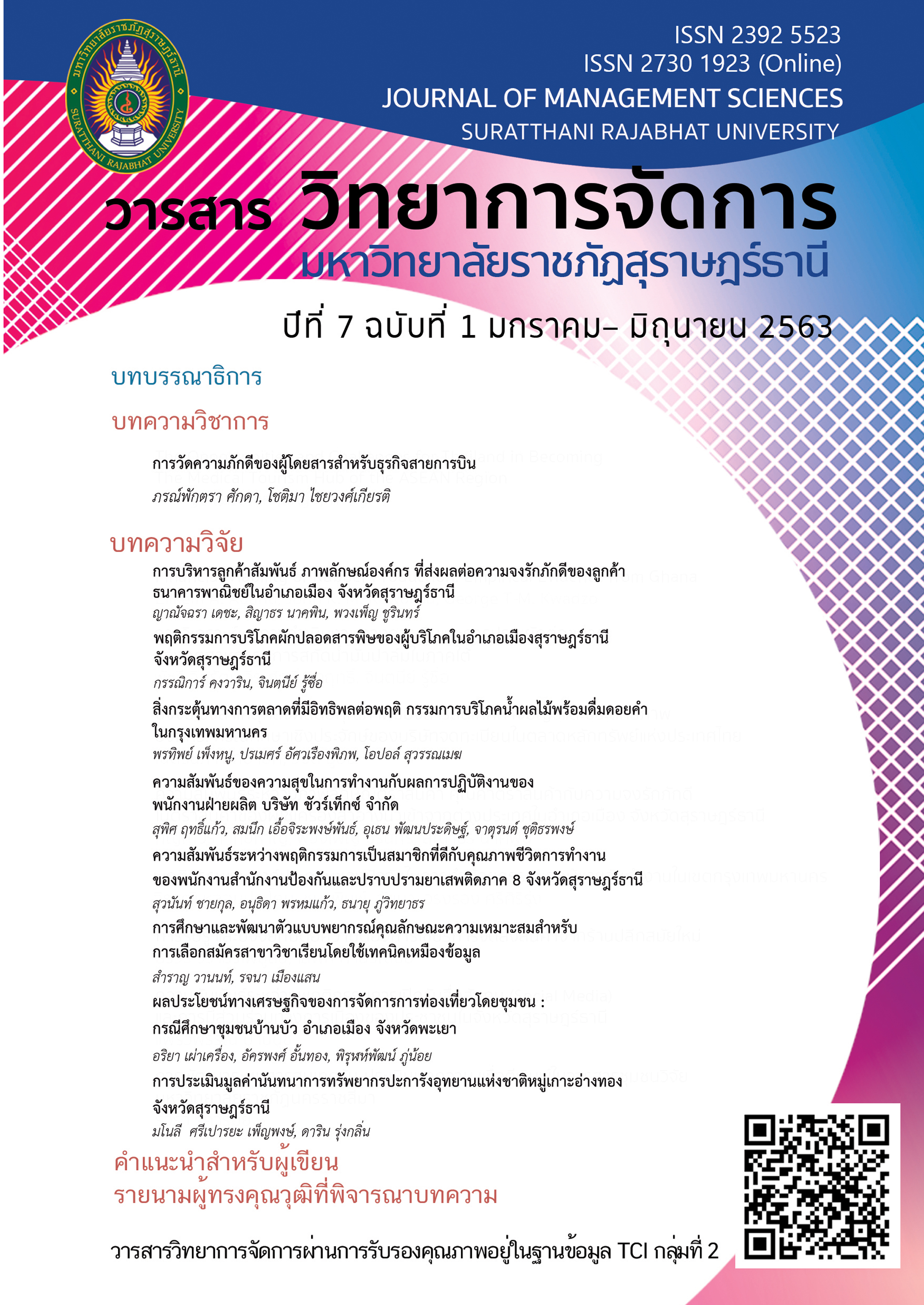Consumer's Behavior in Pesticide - Free Vegetable and Produce Consumption in Suratthani Province
Main Article Content
Abstract
This research aimed to study Behavior among consumers of and Pesticide – Free Vegetables and Produce in Suratthani Province. Psychological factors that affect consumer’s behavior in Pesticide – Free Vegetables and Produce in Suratthani Province; and Marketing Mix factors affecting behavior in Pesticide – Free Vegetables and Produce in Suratthani Province. The questionnaire was used as a tool for collecting data. The samples were composed of 415 individuals. The results were analyzed with descriptive statistics and inferential statistics (Chi–Square) with statistical significance at 0.05.
The results show that the most respondents were female, married, aged 31 – 40 years old, and earned a Bachelor degree, business owners with an income of more than 21,001 baht per month, and without children in the household. The demographic factors (sex age income education marriage status and Occupation) were found to be highly correlated to consumer’s behavior in buying Pesticide–Free Vegetables and Produce in Suratthani Province with statistical significance at 0.05. Pesticide–Free Vegetables and Produce more often bought by female than male. On the other hand, the number of children in household had no influence. For psychological factors, the respondents had a high level of Awareness, Motives and Attitude, Most showed consent with consuming pesticide – free vegetables and produce. In sum, the consumer’s behavior was correlated to psychological factors significantly at 0.05. Marketing mix factors were found at high level and, correlated to consumer’s behavior in consuming pesticide – free vegetables and produce in Suratthani Province that statistically significant at 0.05.
Article Details
References
กรมส่งเสริมการเกษตร กองป้องกันและกำจัดศัตรูพืช. (2539). คู่มือการปลูกผักให้ปลอดจากสารพิษ.กรุงเทพมหานคร : โรงพิมพ์กรุงเทพ.
กัลยา วานิชย์บัญชา. (2549). สถิติสำหรับการวิจัย. พิมพ์ครั้งที่ 2 : โรงพิมพ์จุฬาลงกรณ์มหาวิทยาลัย.
ฐิติมา เทียนไพร. (2550). พฤติกรรมการเลือกซื้อผักปลอดสารพิษของผู้บริโภคในอำเภอเมือง จังหวัดสุราษฎร์ธานี. หลักสูตรปริญญาบริหารธุรกิจมหาบัณฑิต. มหาวิทยาลัยแม่โจ้.
ธงชัย สันติวงษ์. (2539). พฤติกรรมผู้บริโภคทางการตลาด. (พิมพ์ครั้งที่ 7). กรุงเทพมหานคร : โรงพิมพ์ไทยวัฒนาพานิช.
ธวัลยา สิทธิยศ และธีรเวช ทิตย์สีแดง. (2557). ปัจจัยด้านความคิดเห็นที่มีผลต่อพฤติกรรมการซื้อข้าวอินทรีย์ของผู้บริโภค. วท.บ.: สถานบันเทคโนโลยีพระจอมเกล้าคุณทหารลาดกระบัง.กรุงเทพมหานคร.
นงนุช โกสียรัตน์. (2553). การศึกษาความต้องการบริโภคผักปลอดสารพิษของผู้บริโภคในร้านค้าเพื่อสุขภาพ แขวงศิริราช. วิทยานิพนธ์ หลักสูตรปริญญาศิลปศาสตรมหาบัณฑิต.: มหาวิทยาลัยศิลปากร.
ประทานทิพย์ กระมล. (2557). ปัจจัยที่มีผลต่อพฤติกรรมการซื้อผลผลิตเกษตรอินทรีย์ และปลอดสารพิษในตลาดเกษตรกรในจังหวัดเชียงใหม่. วารสารแก่นเกษตร: มหาวิทยาลัยเชียงใหม่, 42(2), 227 – 234.
พรรณรินทร์ อภิรัตนอุดม. (2552). พฤติกรรมการบริโภคผักของประชาชนในจังหวัดสุราษฎร์ธานี. วิทยานิพนธ์ หลักสูตรบริหารธุรกิจมหาบัณฑิต.: มหาวิทยาลัยราชภัฎสุราษฎร์ธานี
พิมพ์กานต์ดา เทพวงษ์. (2013). การรับรู้ และพฤติกรรมการบริโภคผักปลอดสารพิษของครู โรงเรียนสังกัดเทศบาลนครขอนแก่น จังหวัดขอนแก่น. หลักสูตรบริหารธุรกิจมหาบัณฑิต.วิทยาลัยบัณฑิตศึกษาการจัดการ.: มหาวิทยาลัยขอนแก่น.
วีระพล สุทธิพรพลางกูร และเฉลี่ยว แก่นจันทร์. (2538). ปัจจัยที่มีผลกระทบต่อความสำเร็จขององค์กรชุมชน โครงการวนศาสตร์ชุมชนบนพื้นที่สูง จังหวัดเชียงใหม่.
ศิริวรรณ เสรีรัตน์ และคณะ. (2550). พฤติกรรมผู้บริโภค. กรุงเทพ : บริษัท ธีระฟิมล์ และไซเท็กซ์ จำกัด.
อารี พันธ์มณี. (2546). จิตวิทยาสร้างสรรค์การสอน. กรุงเทพฯ: สำนักพิมพ์ใยใหมเอดดูเคท.
อดุลย์ จาตุรงคกุล และดลยา จาตุรงคกุล. (2550). พฤติกรรมผู้บริโภค. (พิมพ์ครั้งที่ 8). กรุงเทพ : โรงพิมพ์มหาวิทยาลัยธรรมศาสตร์.
อรนุช อาจประจญ. (2558). ความรู้ และพฤติกรรมการบริโภคผักปลอดสารพิษของผู้บริโภคในเขตกรุงเทพมหานคร. หลักสูตรบริหารธุรกิจมหาบัณฑิต.: มหาวิทยาลัยธุรกิจบัณฑิตย์.กรุงเทพมหานคร.
อริศรา รุ่งแสง. (2555). ปัจจัยที่มีผลต่อพฤติกรรมการซื้อผักปลอดสารพิษของผู้บริโภคในเขตกรุงเทพมหานคร. สารนิพนธ์ หลักสูตรปริญญาบริหารธุรกิจมหาบัณฑิต.: มหาวิทยาลัยศรีนครินทร์วิโรฒ.กรุงเทพฯ
อรุณี เอกพาณิชย์ถาวร และกิตติพันธ์ คงสวัสดิ์เกียรติ (2554). ปัจจัยที่มีอิทธิพลต่อการตัดสินใจซื้อผักปลอดสารพิษของผู้บริโภคในเขตกรุงเทพมหานคร. วารสารการเงิน การลงทุน การตลาดและการบริหารธุรกิจ, 1(1), 72 – 91.
Ajzan Icek. (1991). The Theory of Planned behavior. Org. Behav Hum Decision Processes 50, 179 – 211.
Chiew Shi Wee, Khalid Ismail and Nawawi Ishak. (2014). Consumers Perception, Purchase Intention and Actual Purchase Behavior of Organic Food Products. Review of Integrative Business & Economics Research, 3(2), 378 – 397.
Henry, A. (1995). Consumer Behavior and Marketing Action. The United of America : International Thomson Publishing.
Kast, F.E., Rosenzweig and James E. (1985). Organization and Management : A system and Contingency Approach. New York: Mc Graw – Hill.
Kotler, P. (1997). Marketing management analysis, planning, implementation and control (9th ed.). Englewood Cliffs, NJ: Prentice-Hall.
Kotler Philip. (2009). Marketing Management. Peaso Prentice Hall.
Maria Magnasson. (2004). Consumer Perception of Organic and Genetically Modified Foods. Uppsala University. Sweden.
Parichard Sangkumchaling and Wen-Chi Huang. (2012). Consumers’ Perceptions and Attitudes of Organic Food Products in Northern Thailand. Journal International Food and Agribusiness Management Review, 15(1), 87 – 102.
Peeraya Somsak and Markus Blut. (2012). An Evaluation of Buying Behaviors and Perception of Organic Vegetable Consumer in Chiang Mai Province. The Asia Business and Management Conference 2012 Official Conference Proceedings, Osaka, Japan, 1 – 14.
Pittawat Ueasangkomsate and Salinee Santiteerakul. (2016). A Study of Consumers’ Attitudes and Intention to buy Organic Foods for Sustainability. Procedia Environmental Science, 34(2016), 423 – 430.
Sanjeev Kapoor and Niraj Kumar. (2015). Fruit and Vegetable Consumers’ Behavior : Implications for Organiaed Retailers in Emerging Market. Journal of Intenational Food & Agribusiness Marketing, page 1 – 25.
Schermerhorn, J.R., Hunt, J.G. & Osborn, R.N. (1982). Managing organizational behavior. Newyork : John Wiley and Sons.
Tina Vukasovic. (2015). Attitudes towards organic fruits and vegetables. Agricultural Economics Review, page 20 – 34.


